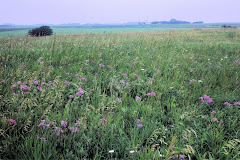On Tuesday, June 21, 1838 an exploration party led by Joseph N Nicollet was a few miles to the north of the Jeffers Petroglyph's site. They were following the Cottonwood River heading toward the Pipestone quarries to the west. The Little Cottonwood River is very close to the petroglyph's site. On this June day thickets of wild roses were in bloom in the region. A southeast wind was blowing with a clear sky and the air was perfumed by the wild roses.
The explorers noted a plateau area toward which they were moving. Looking to the south they would have seen over a valley to another plateau where the petroglyph's could be found. But they were not aware of the site and did not take that route.
As they continued they noted an elevation about 1/3 mile long and 60 feet above the green plain of the prairie and near the river. It was just about 8 years before that Indian people came there to watch herds of buffalo arrive in the area. The place was called "Indian Lookout Mount". It was near present day Lamberton, Minnesota.
Nicollet says that the Cottonwood River at that time was a clear flowing stream with sand bottom. The prairie was undisturbed by cultivation, railroads, roads, communities or any other permanent sign of human presence. Indian people led a nomadic life much in harmony with the natural scene.
I include this information to give evidence of the nature of the Minnesota prairie and the grandeur of the scene greeting Nicollet's team. The information comes from the Journals of Joseph Nicollet translated from the French and edited by Edmund C. Bray and Martha Coleman Bray. This 1976 publication by the Minnesota Historical Society is entitled "Joseph N. Nicollet on the Plains and Prairies: The Expeditions of 1838-39 With Journals, Letters, and Notes on the Dakota Indians."
Monday, January 28, 2008
Subscribe to:
Post Comments (Atom)




No comments:
Post a Comment